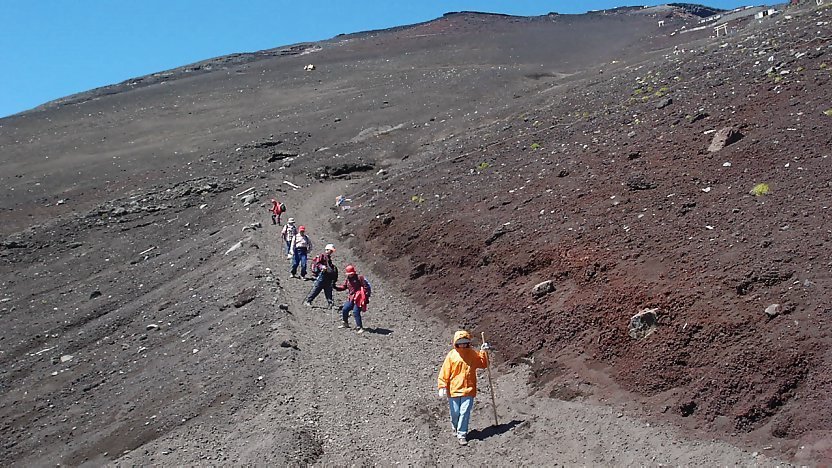Climbing Mount Fuji (3776 meters), Japan’s highest and most prominent mountain, can make for lifelong memories. The mountain itself may look more attractive from afar than from close up, but the views on clear days and the experience of climbing through the early morning hours among hundreds of equally minded hikers from across the world are very rewarding.
What was new in 2024?
Starting in 2024, the four trailheads to the summit of Mount Fuji were closed during the late afternoon and evening (from 4pm to 3am), except for hikers staying at huts. The aim was to prevent people from climbing through the night, which is blamed by the local authorities to cause an increased number of troubles on the mountain.
Furthermore, a daily limit of 4000 hikers and a 2000 yen entry fee was introduced along the most popular Yoshida Trail on the north side of Mount Fuji (in addition to the existing 1000 yen fee). An online reservation system allowed 3000 slots per day to be reserved and paid online in advance. The remaining 1000 slots were allocated to same-day entries at the trailhead.
No limits and mandatory entry fees were introduced along the other three trails. Instead, hikers along the other trails were asked to submit an online application and watch a preparatory video about the climb in advance. They then received a QR code to be shown at the trailhead, while those without QR codes were asked to register themselves and watch the video at the trailhead before starting their climb.
What will be new in 2025?
Shizuoka Prefecture announced to introduce entry gates, climbing fees and limits on the number of hikers also on its three trails to Mount Fuji’s summit (the Fujinomiya, Subashiri and Gotemba trails) from 2025. The fee for hiking Mount Fuji in 2025 is expected to be set to 4000 yen on all four trails – on the Shizuoka and Yamanashi sides – while the 1000 yen voluntary contribution is expected to be discontinued. Furthermore, the gates at the trailheads are expected to be closed two hours earlier than in 2024, from 2pm to 3am.
When to climb?
Official climbing season
Early July to mid September is the official climbing season when the trails and mountain facilities are open. During this period the mountain is usually free of snow, the weather is relatively mild, access by public transportation is easy, and the mountain huts are open. In recent years the official season has been set as follows:
- Yoshida Trail: July 1 to September 10
- Subashiri, Gotemba and Fujinomiya Trails: July 10 to September 10
The crowds
Climbing Mount Fuji is very popular not only among Japanese but also foreign tourists, who make up a significant minority of hikers. The peak season for climbing Mount Fuji is during the school vacations, which last from around July 20 to the end of August. The peak of the peak is reached during the Obon Week in mid August and on weekends (especially Saturdays), when climbers literally have to stand in queues at some passages.
Starting in 2024, a daily limit of 4000 hikers will be introduced along the Yoshida Trail, the most popular of the four trails leading up to the summit, and an online system allows for advance reservations of hiking slots. Note that in past years, this number has been exceeded only on a few particularly busy days. No limits are set along the other three trails.
While we recommend to avoid the super busy days, we believe that by avoiding the crowds in general, you would miss out one of the most interesting aspects of climbing Mount Fuji, which is the camaraderie and unique experience of ascending the mountain among hundreds of equally minded people from across the world.
In order to encounter neither too large nor too small crowds, we recommend to climb Mount Fuji on a weekday in the first half of July before the start of the school vacations. The downside of a climb in early July is the weather, which tends to be more unstable than later in the season.
Off-season
Some mountain huts open a few days before the start of the official climbing season and/or remain open until around mid September. Public transportation, is considerably less frequent or non-existent outside of the official climbing season.
While there is usually no snow on Mount Fuji from late June until October, temperatures at the summit can drop to far below zero in the shoulder seasons. Only experienced hikers should consider the ascent in late June or September. If there is snow on the mountain, appropriate mountaineering equipment and experience is required.
From October to around mid June, climbing to the summit is highly perilous due to extreme wind and weather conditions, snow, ice and a risk of avalanches.
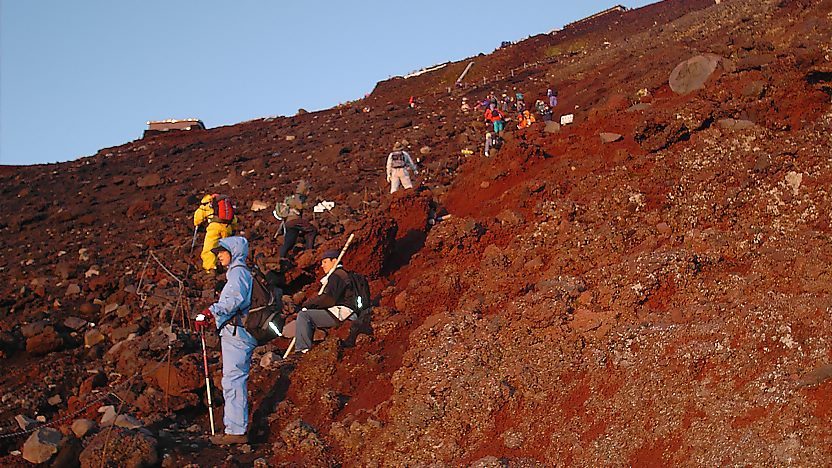
The trails
Mount Fuji is divided into ten stations with the first station at the foot of the mountain and the tenth station being the summit. Paved roads go as far as the fifth station halfway up the mountain. There are four 5th stations on different sides of the mountain, from where most people start their ascent:
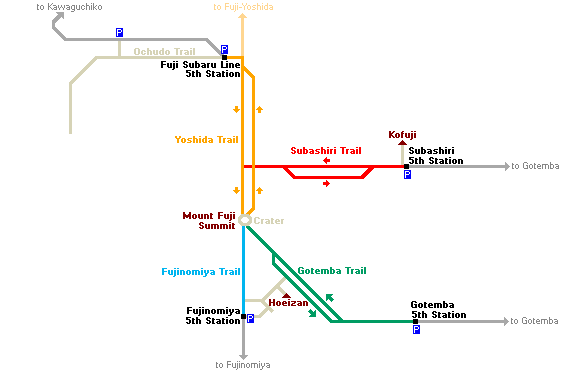
- Fuji Subaru Line 5th Station (Yamanashi Prefecture)
Yoshida Trail
Altitude: about 2300 meters
Ascent: 5-7 hours
Descent: 3-5 hours
Daily limit: 4000 hikers
Mandatory fee: 2000 yen
This is the most popular base for the climb to the summit, and the most easily accessible 5th station from the Fuji Five Lake region and central Tokyo. Lots of mountain huts line the trail around the 7th and 8th stations, and there are separate trails for the ascent and descent. The sunrise takes place on this side of the mountain. Daily limits on hikers and a mandatory admission fee were introduced in 2024 along this route. More details… - Subashiri 5th Station (Shizuoka Prefecture)
Subashiri Trail
Altitude: about 2000 meters
Ascent: 5-8 hours
Descent: 3-5 hours
No daily limit and mandatory fee
This 5th station at only 2000 meters above sea is the base of the Subashiri Trail, which meets the Yoshida Trail around the 8th station. More details… - Gotemba 5th Station (Shizuoka Prefecture)
Gotemba Trail
Altitude: about 1400 meters
Ascent: 7-10 hours
Descent: 3-6 hours
No daily limit and mandatory fee
This is by far the lowest 5th station, and the ascent to the summit is accordingly much longer than from the other 5th stations. There are about four huts around the 7th and 8th stations. More details… - Fujinomiya 5th Station (Shizuoka Prefecture)
Fujinomiya Trail
Altitude: about 2400 meters
Ascent: 4-7 hours
Descent: 2-4 hours
No daily limit and mandatory fee
The closest 5th station to the summit, the Fujinomiya 5th Station is the base for the southern approach via the Fujinomiya Trail. It is easily accessible from stations along the Tokaido Shinkansen. There are half a dozen mountain huts along this trail. More details…
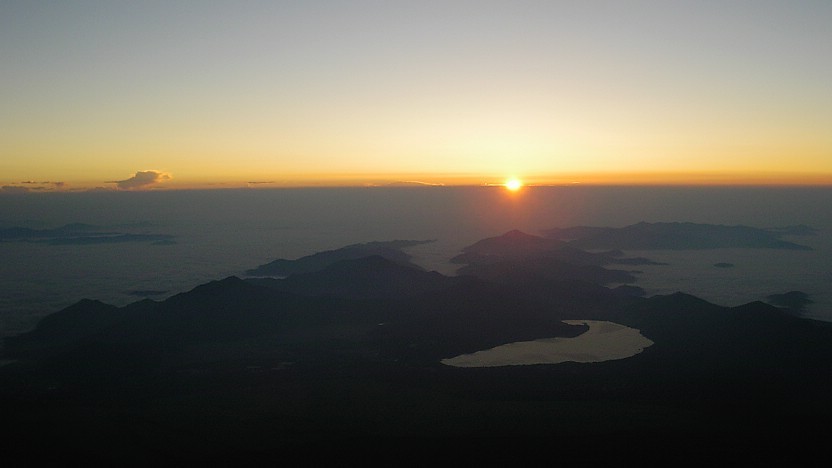
How to climb?
Is it difficult?
The ascent to the summit does not pose any major difficulties regarding climbing skills. Only at some points the terrain is rather steep and rocky. Abundant signs along the trail warn the hikers of other minor problems such as sudden wind gusts and falling rocks. However, the main challenge of the climb is the fact that it is very long and strenuous and the air gets notably thinner as you gain altitude.
Is it recommended to hire a guide?
Because the hike is not technically difficult, and there are many other hikers during the climbing season, the average person will not need a guide. However, inexperienced hikers or people who prefer to leave all the planning to somebody else may want to consider hiring a guide. There are several companies offering group or private tours, such as Klook and Willer.
Timing
Most people try to time their ascent in order to witness the sunrise from the summit. Also, the chances of the mountain being free of clouds are highest during the early morning hours.
The recommended way of doing this, is to climb to a mountain hut around the 7th or 8th station on the first day and spend some hours sleeping there before continuing to the summit early on the second day. Sunrise in summer is as early as 4:30am to 5:00am.
In the past, many hikers started climbing the mountain in the late evening from the 5th Station and hiked through the night to reach the summit around sunrise. Known as “bullet climbing”, this way of climbing Mount Fuji, however, is blamed by local authorities for an increased number of troubles on the mountain because it is more tiring and brings an increased risk of altitude sickness and injury. For this reason, the trailheads will be closed between 4pm and 3am to prevent people from hiking overnight, starting in 2024. Only hikers with a hut reservation are allowed to start their ascent between 4pm and 3am.
Ascending and descending the mountain in a single day during daytime is also possible, but again it is not recommended for the same reasons as above. Furthermore, the mountain provides very little shelter, leaving climbers fully exposed to the sun. Visibility also tends to be worse during daytime when the mountain is frequently wrapped in clouds.
A walk around the crater of Mount Fuji takes about one hour. The mountain’s and Japan’s highest point is located immediately next to the weather station on the opposite side from where the Yoshida Trail reaches the peak.
Mountain huts
The Yoshida Trail is lined by more than a dozen mountain huts between the 7th and 8th stations. Other trails have fewer mountain huts. An overnight stay costs typically around 13,000 to 15,000 yen per person with two meals. Expect the huts to be extremely crowded during the peak. Reservations should be made in advance; however, a considerable number of huts don’t accept reservations online or in English or sell out quickly. Check the external links below for lists of mountain huts.
Most mountain huts offer paid toilets (typically 200-300 yen for non-staying guests) and sell food, water and other climbing provisions such as canned oxygen. In addition, most of the huts have special branding irons they use to brand the wooden hiking sticks (for a small fee) that many hikers purchase when climbing the mountain.
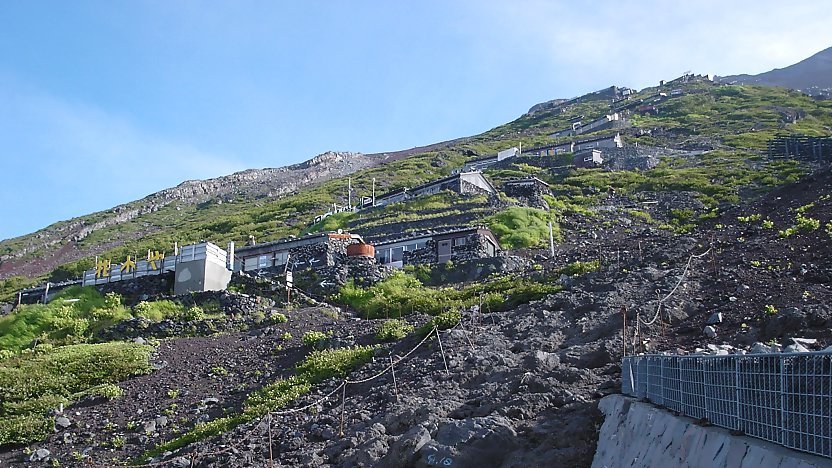
Climbing equipment
In order to enjoy a safe hike to the summit of Mount Fuji, it is crucial to bring the proper equipment. Some of the most important things to bring are listed below:
- Proper shoes
The rocky, steep terrain in some sections and the potential of sudden, strong wind gusts are reasons to bring proper hiking shoes which protect your ankles. - Proper clothes
Bring proper protection against low temperatures and strong winds. It can be below zero at the summit, and strong winds often make it even colder. Bring rain gear, as weather conditions can change very quickly on the mountain. Gloves are recommended both against the coldness and for hiking the steep, rocky passages. - Flashlight
If you hike at night, a flash light is highly recommended in any season and essential outside of the peak season when the trail is not illuminated by other hikers. Most people choose head lamps, as they leave both of your hands free. - Food
It is important to bring enough water and food, particularly on the trails where there are few mountain huts along the way. Mountain huts offer various meals and drinks; however, note that prices increase with the altitude. Also, be prepared to carry home all your garbage as there are no public garbage bins on the mountain. - Money
Cash is necessary to buy provisions on the mountain like water or canned oxygen and to use the toilets along the way. It is also important to carry should you need to seek emergency shelter in one of the mountain huts. - Hiking stick (optional)
While not crucial, many hikers purchase wooden hiking sticks at the 5th Station to aid in their climb up the mountain. Hiking sticks cost about 1500-2000 yen and are sold at the 5th stations. In addition, for a few hundred yen you can get your hiking stick branded at the mountain huts along the way, turning it into a much cherished souvenir of your journey.
Manners
- Do not pick plants!
- Do not bring home any stones!
- Do not camp on the mountain!
Admission fee
During the climbing season, climbers of Mount Fuji are asked to contribute 1000 yen per person at collection stations at each trailhead. The money is used to cover some of the expenses arising from the huge number of climbers visiting the mountain each summer, especially regarding the protection of the environment and safety of climbers.
In addition, a mandatory fee of 2000 yen was introduced along the most popular Yoshida Trail in 2024. An online reservation system allows for advance reservations and online payments. Same-day purchases are possible at the trailhead, but note that there is a daily limit of 4000 hikers, which can be surpassed on particularly busy days.
Altitude sickness
The human body requires some time to adjust to a sudden increase of altitude, otherwise there is a risk of headache, dizziness and nausea. Quite a few people who climb Mount Fuji, suffer from altitude sickness.
To avoid altitude sickness, you are advised to tackle the mountain at a slow pace, stay hydrated and make frequent breaks. An overnight stay at a hut around the 7th or 8th station is recommended as opposed to a straight climb to the top. Small bottles of oxygen, available at the 5th stations and mountain huts, can be an effective tool in preventing and fighting altitude sickness; however, the only reliable treatment is to descend the mountain.
